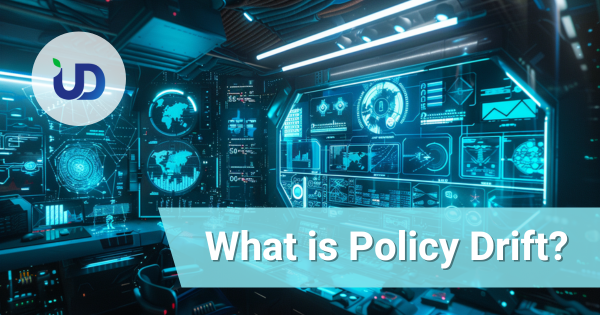Policy Drift in Cybersecurity: The Hidden Threat Audits Fail to Detect
Policy Drift is one of the most underestimated cybersecurity risks in modern organizations. While companies invest heavily in firewalls, vulnerability scans and annual audits, a quiet threat continues to grow behind the scenes: the gradual and unnoticed deviation of security controls from their original policies. This security gap often remains invisible until a real incident happens, making Policy Drift a critical topic for businesses relying on consistent and scalable security governance.
In this tutorial-style article, you will learn what Policy Drift is, why traditional audits fail to detect it, how it impacts real-world security operations, and what organisations can do to prevent it.
What Is Policy Drift and Why It Happens
Policy Drift refers to the slow, incremental and often unintentional divergence between what your security policy states and what your actual systems are doing. Over time, configurations, permissions, controls and processes start moving away from the documented standard.
This drift typically begins with small changes: a firewall rule added for “temporary testing”, a developer with elevated cloud permissions that never get revoked, or a patching policy that gets postponed due to operational pressure. None of these feel critical at the moment, but together they create a long-term gap between theory and reality.
Policy Drift is especially common in fast-moving environments such as cloud infrastructure, CI/CD pipelines, distributed teams and organisations with constant staff turnover.
Why Traditional Security Audits Often Miss Policy Drift
Many organisations assume that their annual audit, SOC report or compliance assessment will catch misalignments. However, Policy Drift is uniquely difficult for audits to detect because audits are designed to review a snapshot, not continuous change.
Auditors rely on documented procedures, structured evidence samples and interviews rather than real-time operational activity. This means they see how your policy is supposed to work, not how it behaves on a daily basis. As long as your documentation looks solid on audit day, the underlying drift remains hidden.
Even worse, some companies temporarily “fix” issues right before an audit. After the audit is complete, drift begins again—this time even faster.
The Real-World Risks Created by Policy Drift
Policy Drift introduces hidden security gaps that attackers can exploit long before anyone notices something is wrong. Misconfigurations accumulate, permissions extend beyond necessary roles, and undocumented exceptions become permanent loopholes.
Over time, the organisation experiences a silent widening of the attack surface. This can lead to increased exposure to credential abuse, data leakage and privilege escalation. Drift also makes incident response more difficult because IT teams may be unaware of undocumented deviations, making it harder to trace the origin of a security event.
When systems drift far enough, compliance violations also occur. Because drift happens gradually, organisations may believe they are compliant, while in reality they operate outside regulatory standards without knowing it.
How Policy Drift Damages Modern Cloud and DevOps Environments
Cloud environments are especially vulnerable to Policy Drift because of their dynamic nature. Cloud configurations change constantly, and human-driven adjustments create inconsistencies that are rarely tracked. The concept of “temporary exceptions” is one of the most common sources of drift—permissions granted for a quick task but never removed.
In DevOps pipelines, rapid deployments lead to configuration changes at high frequency. Teams add secrets to temporary locations, modify access rules for troubleshooting, or adjust configurations for urgent releases. Without continuous governance, these drifted settings become permanent vulnerabilities.
When using modern platforms such as Kubernetes, serverless functions or API gateways, the complexity further amplifies drift. More components mean more opportunities for misalignment between policy and reality.
Preventing Policy Drift with Continuous Security Governance
The only reliable way to eliminate Policy Drift is through continuous visibility and automated enforcement. Instead of waiting for annual audits, organisations must adopt real-time monitoring and frequent validation of security controls.
Continuous security tools detect configuration changes as they happen and compare them against baseline policies. This provides instant alerts when systems deviate from expected behaviour. Automated remediation tools can also revert unauthorised changes immediately, reducing the attack window.
Security teams should also enforce a culture where temporary exceptions have expiration dates, mandatory review cycles and clear documentation. Since drift often stems from human shortcuts, strong operational discipline is essential.
A well-maintained identity and access management (IAM) process also helps reduce drift by ensuring that permissions and roles do not grow unchecked. In cloud environments, this includes using infrastructure-as-code (IaC) to maintain consistent configurations across environments.
Why Businesses Should Take Policy Drift Seriously
Policy Drift is not a technical inconvenience—it is a quiet but powerful undermining of your entire security architecture. Even the best policies become useless if real-world operations no longer follow them. Attackers thrive on these inconsistencies because they often lead to predictable vulnerabilities.
Eliminating drift strengthens operational resilience, improves compliance, reduces audit fatigue and increases confidence in your organisation’s cybersecurity maturity. Most importantly, preventing Policy Drift ensures that your security strategy is not just well-designed on paper, but effectively executed every day.
🛡️ Ready to Strengthen Your Security?
UD is a trusted Managed Security Service Provider (MSSP)
With 20+ years of experience, delivering solutions to 50,000+ enterprises
Offering Pentest, Vulnerability Scan, SRAA, and a full suite of cybersecurity services to protect modern businesses




